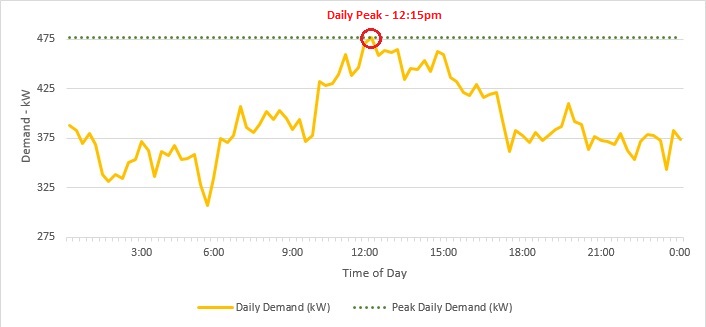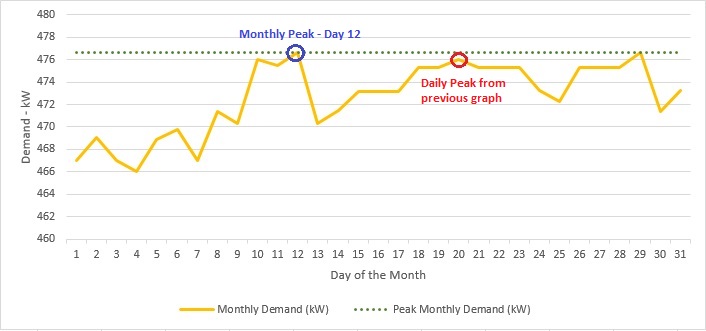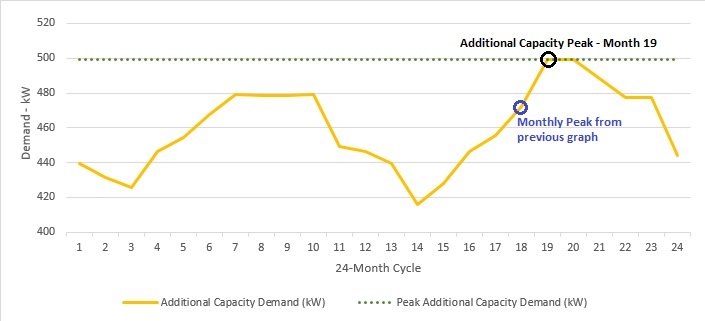
Effective January 1, 2018, all Large Commercial Customers, and any customers with Distributed Energy Resources (DER) will be billed utilizing demand charges. For Large Commercial Customers without DER, the implementation will be phased in over three years. For customers with DER, the implementation will be immediate.
What are Demand Charges?
The existing line item on bills, the Energy Charge, is based on the calculation of total electrical consumption, in kilowatt-hours (kWh), during your billing period. Demand charges are based on the rate at which a location consumes electricity – the amount, in kilowatts (kW) needed to power your premises at any given point in time. Demand dictates the required equipment, facilities, and other electrical apparatus necessary for CUC to service your location, regardless of the amount of electricity consumed.
On customers’ bills there are two components related to demand – monthly peak demand and additional capacity. They represent, respectively, the short-term and long-term demand for your location.
Monthly peak demand represents the highest recorded demand interval for your location during the billing period. Additional capacity is the highest recorded monthly peak demand for your location over the previous 24 months. Additional capacity represents the longer-term nature of your business’ demand requirements.
Why Use Demand Charges?
Using demand charges coupled with energy charges allows for a more representative reflection of the costs of servicing your location. The energy charge (variable) is directly linked to your consumption – the more you use, the more charged and vice versa. The demand change (fixed) is directly linked to the infrastructure required to service the greatest rate at which you need for your usage. In that manner, a lower-demand customer who uses (consumption) the same amount of kWh as a higher-demand customer will have the same energy charges on their bill, but the higher-demand customer will have higher demand charges reflecting the additional cost of infrastructure required to meet their higher demand rate.
Overall, the change to the use of demand rates is revenue-neutral to CUC; however, the changes will impact customers differently. Initially some will see an increase and others a decrease, depending on the nature of their business. Demand billing does provide you, our customer, greater control regarding final billed cost for electricity. By tracking your consumption patterns utilizing Customer Connect, you will be able to correlate your operational functions to your demand and make cost-informed choices, accordingly.
The purpose of two demand-related charges is that the facilities required to service your location may vary in the short-term (potentially due to changes you may make to your operations to reduce demand), but CUC must maintain the capacity to service your highest long-term demand in the event that your location might need it at any point in time thereafter.
The difference in the rates applicable to the demand charges reflects the costs of the facilities, equipment, and other apparatus CUC must have in place, whether in active use or standby, in the short term (reserve generation capacity to meet peak and intermittent load, for example) and long term (transmission & distribution infrastructure, generation capacity to meet base load, etc.).
In the long-term, sustained changes made by your location to reduce and flatten your monthly demand will, over time, lead to the reduction in your additional capacity charge commensurately. As the longer-term additional capacity requirements are reduced or flattened by multiple locations, infrastructure and demand forecasting will be improved and can lead to lower rates at the next rate review and savings to be passed on to all customers through improved efficiencies and tightened reserve capacity margins.
Daily Demand:

Monthly Demand:

Additional Capacity:

Current Demand Rates:
| Monthly Rate | PR | PC | PL | L |
|---|---|---|---|---|
| Facilities Charge | $6.36 | $35.13 | $184.20 | $184.20 |
| Energy Charge (kWh) | $0.00399* | $0.00387* | $0.00391* | $0.00409* |
| Monthly Demand Charge (kW) | $4.42 | $9.87 | $14.70 | $9.81 |
| Additional Capacity Charge (kW) | $11.15 | $22.64 | $35.58 | $23.72 |
*Recovery of deferred base rate revenues from June 1, 2020 to December 31, 2020, will take place via a $0.0013/kWh increase to listed Energy Charge rates for the period of January 1, 2023 through December 31, 2024.
Customer Rate Class:
PR - Residential Location with DER
PC - Small Commercial Location with DER
PL - Large Commercial Location with DER
L - Large Commercial Location without DER
Additional Resources:
Below are attached additional resources, communications, and information for your reference and use.
Any further questions can be answered by our Customer Service Team at 949-5200 or via e-mail at service@cuc.ky .